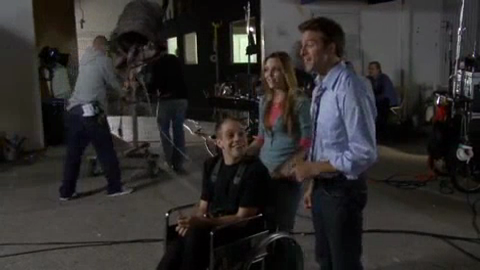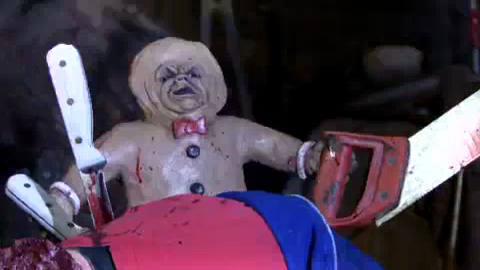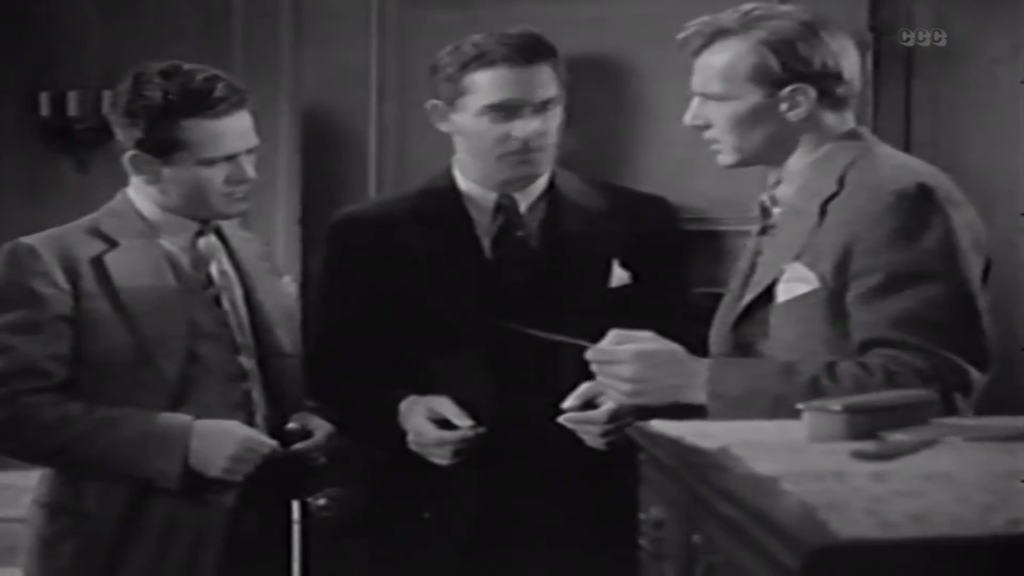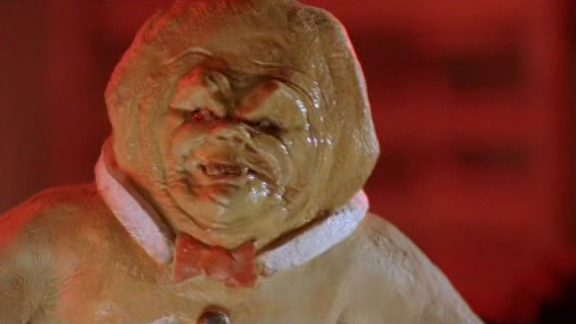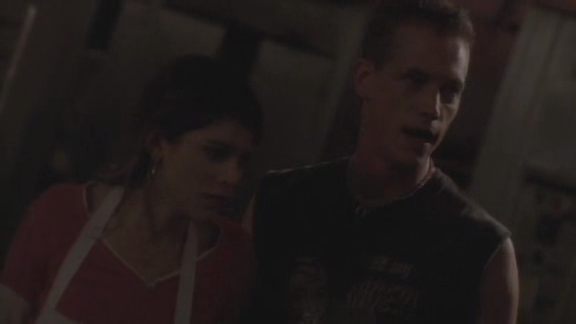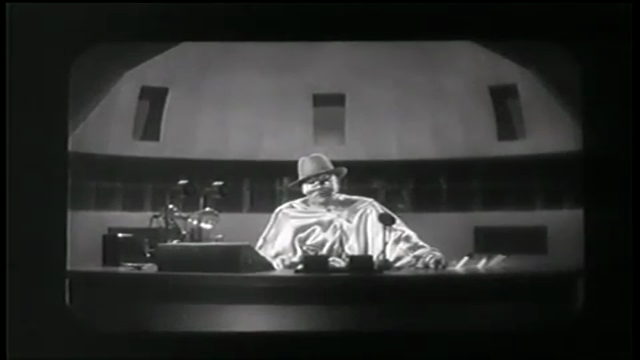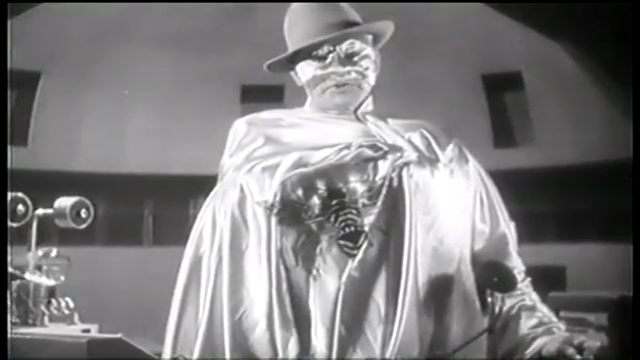-
#443 – Gingerdead Man 2; Passion of the Crust (2008)
Gingerdead Man 2: Passion of the Crust (2008)
Film review #443
Director: Silvia St. Croix
SYNOPSIS: At the production of another cheap horror movie, the production team are dealing a myriad of problems that only get worse when the Gingerdead Man turns up in a box of pastry and goes about slaughtering the staff in order to enact and ancient spell to return hi to human form…
THOUGHTS/ANALYSIS: Gingerdead Man 2: Passion of the Crust is a 2008 comedy horror film and the sequel to the 2006 film The Gingerdead Man. The film centres around a low-budget film production studio, where their are problems abound with it’s latest production, and director Kelvin Cheatum is trying to keep everything together on set. They are visited by Tommy and his carer Heather from the “End of the Rainbow Last Wish Foundation” (obvious parody of the make-a-wish foundation) in order to fulfil Tommy’s dying wish of seeing where his favourite movies are made. Polly Bonderhoof attempts to bring some peace to the set with a box of freshly baked pastries from her sister, but unfortunately one of those pastries is the Gingerdead man himself, who stumbles upon a spell book that contains a spell to transmigrate his soul into a human body, requiring the blood of six victims to perform it. With this in mind, The Gingerdead Man starts off on another killing spree to accomplish his goal. The film starts off by recapping the events of the first film, but none of the original cast are in this sequel or even mentioned apart from The Gingerdead Man, so it seems pretty pointless to recap those events…unless, of course, it’s to pad out the runtime, which I’m pretty certain is what is happening. Most of the film doesn’t even feature The Gingerdead Man at all, but rather focuses on the other characters who aren’t really that interesting. It’s only in the last act that he becomes the focus of some attention, whereas for the rest of the film he is skulking around in the background talking to himself, and the kills are not a point of interest, which is pretty essential for a slasher flick.
The characters apart from the Gingerdead Man aren’t all that interesting, although they do have some development and a few twists along the way. You can’t help but feel you’re not really interested in them though in comparison to what the Gingerdead Man is doing. It’s never explained how the Gingerdead Man returned after the first one, but since none of the other characters or plot points return, it’s not an issue that is lingered upon.
Being set in a movie studio, I think it’s pretty obvious that this is used as cover to use film equipment and sets as part of the film itself to make it cheaper to produce. Some of the puppets are decently designed and animated, and the sets are at least fairly full of props and scenery to make it look somewhat genuine. One of the big problems is that a lot of the Gingerdead Man’s scenes and the subsequent gore are shot close up (so you obviously can’t see the wires or puppetry), and as such, you don’t really get a sense of action and movement from these shots. The film also makes a habit of having long scenes of dialogue that dissipates any sense of pacing or tension. I think the film is also a bit of a self-commentary on the production company Full Moon Pictures, which itself makes low-budget horror films, but whether this is something average film goers will appreciate is debatable. The film ends with the Gingerdead Man being crucified by the other puppets, which I guess fulfils the subtitle of the movie, but is the only thing that does. Overall, Gingerdead Man 2: Passion of the Crust suffers from the problems of its predecessor, but has a more interesting setting and story that ties up all the characters. It doesn’t pretend to be anything other than a low-budget slasher comedy, so you get what you would expect, but with a bit more polish than its predecessor.
-
#442 – Daredevils of the Red Circle
Daredevils of the Red Circle (1939)
Film review #442
Directors: William Witney, John English
SYNOPSIS: Three daredevils are performing their regular circus act when sabotage leads to a huge fire breaking out, and the death of the young brother of one of the performers leads to them wanting to seek revenge. They learn that a former prisoner is responsible, and is attempting to destroy the properties of Granville, the man which put him away. The daredevils team up with Granville, but little do they know that the Granville they are working with is actually prisoner “39013″, who has assumed Granville’s identity and kept the real one locked up in his basement as a means to exact his revenge. The daredevils must work together to stop 39013 and unravel the mystery, aided by a mysterious ally known as the “Red circle,” who communicates with them only through notes in order to alert them of 39013′s plans and to keep their identity a secret…
THOUGHTS/ANALYSIS: Daredevils of the Red Circle is a 1939 serial film comprised of twelve chapters. The serial opens up with the daredevils Gene, Tiny and Burt performing their show at a circus owned by millionaire philanthropist Horace Granville. Meanwhile, ex-prisoner and former business partner of Granville Harry Crowel, who now goes by his prisoner number “39013″ (pronounced thirty-nine oh thirteen), plans to get revenge on Granville, who put him in prison. 39013 sabotages the next show of the daredevils, causing the circus to go up in flames and killing Gene’s kid brother. They decide to get revenge by teaming up with Granville to stop 39013, but little do they know the Granville they are working with is actually 39013 himself, disguising himself as Granville, who is actually locked in the basement, and ruining his life from within. The rest of the serial comprises of the Daredevil’s attempts to foil 39013′s various schemes, while being aided by notes left for them by the mysterious “Red Circle.” The story and format are all very familiar to serial goers, with the opening chapter actually showing off the unique aspects of the characters doing their daredevil tricks and stunts, and then in subsequent chapters hardly ever being seen again, with the aim of the expensively produced first chapter being used to draw viewers in and convince them to come back to the theatre week after week to watch subsequent ones. The death of Gene’s young brother Sammy is an unusually dark premise to open on, as the kid character is a staple of many serials that younger viewers may relate to, rather than them being killed off in the first ten minutes. The rest of the serial is a very familiar story though, with each chapter introducing a new plot to destroy another of Granville’s industries or properties, and the daredevil’s attempting to stop the. There’s some decent variety and action sequences, but nothing too memorable amongst the huge amount of times they have been done across the format.
The characters are the usual suspects in this serial, with the three daredevils being the usual young, athletic, ideal Americans who can pull off all the necessary stunts and fistfights that the story demands. They are all defined as having a speciality in particular aspects of daredevilry, but we never see those particular talents define their character beyond the first chapter, and they all feel very similar to one another. Blanche as the granddaughter of Granville plays the typical token female character and as usual has very little to do for the majority of the serial. 39013 is a fairly typical villain, but at least he has a clear motive and purpose. He is played by Charles Middleton, who most famously was the villain Ming the Merciless in the Flash Gordon serials, and later the villain in the Jack Armstrong serial. The man certainly knows how to play a villain. The rest of the characters don’t leave much of an impression, apart from the dog Tuffie, who is obviously well trained. The one seriously problematic character is that of “Snowflake,” a black man who serves as a “servant” in the Granville household. Like nearly every black person in cinema at this time, they are portrayed as simple-minded and clumsy, alongside being the butt of every joke. Obviously this is an extremely racist and problematic representation that films created and perpetuated during this time, and badly dates the serial.
The serial makes use of some decent settings and set-ups for it’s end-of-chapter cliffhangers, such as chapter two’s flooding tunnel in which one of the daredevils has to escape on a motorbike. The effects aren’t convincing by today’s standards, but are decent for the time. The plot ramps up at the end of the tenth chapter, where 39013 is unmasked and flees while the real Granville is rescued, and this makes a change to everything usually being resolved in the last five minutes in other serials. However, it throws away that excitement by using chapter eleven as a “recap” chapter consisting mostly of clips from the previous chapters, which really stops the excitement in its tracks. Overall, Daredevils of the Red Circle has some decent moments and a fair amount of excitement, but a number of problems make it feel very dated and not really worth returning to.
-
#441 – The Gingerdead Man (2005)
The Gingerdead Man (2005)
Film review #441
Director: Charles Band
SYNOPSIS: Following a robbery in which two people are killed, the criminal is executed for his crimes. Sarah, whose Brother and Father were the ones killed while she survived, is working at her family’s bakery when a mysterious delivery arrives. When she bakes a gingerbread man with this delivery, it comes alive with the soul of the robber that killed Sarah’s family, and seeks to finish the job he started…
THOUGHTS/ANALYSIS: The Gingerdead Man is a 2005 comedy horror film. The film starts off with a robbery in progress at a diner (who robs a diner?), where Sarah watches her brother and father get shot and killed by the robber, but before he can kill her, he is stopped, and eventually executed for his crimes. Years later, Sarah is working at her family’s bakery when a mysterious delivery arrives, and when she bakes a gingerbread using this delivery, it comes alive with the soul of the robber who murdered Sarah’s brother and father, and is looking to finish what he started. The film follows a typical format of horror films, with the cast of various personalities attempting to survive the murderous spree of the villain, who picks them off one by one through somewhat creative deaths. Despite the absurd premise of cursed bakery products, the film for the most part plays it straight, and takes the whole scenario seriously. There’s a few silly one-liners and some of the deaths are over-the-top, but other than that it’s a pretty straightforward affair that doesn’t take much advantage of it’s bizarre premise, and the uneven pacing means that there isn’t really enough tension built up to make it interesting. The whole premise of the robber’s soul being transferred into a gingerbread man isn’t explained at all, and while it’s somewhat easy to piece together what happens, the specifics aren’t explored. This isn’t the type of film to worry about the details though.
The characters resemble a fairly typical horror film cast, full of conflicting personalities and drama between them. There’s Sarah Leigh and the other employees of the bakery ‘Brick’ and Julia, and also Lorna Dean, whose father runs a nearby commercial bakery attempting to put the family-run bakery out of business, and her boyfriend Amos Cadbury (nice sweet-related surname there), with whom a love triangle is set up between him, Sarah and Lorna. A lot of the character development is done through scenes of dialogue that really slow the film down, and also don’t really add anything to what’s going on. The Gingerdead Man himself we hardly see enough of, as he appears only nearly half way through the film, and given it only really has a sixty minute runtime, there’s not much exploration of the set-up, or giving the villain opportunity to creatively enact his killing.
The Gingerdead Man is obviously a low budget affair, with the short runtime, the use of a very limited amount of sets, and plenty of scenes consisting of just talking. Gary Busey as the robber/The Gingerdead Man is the only recognisable casting, and is probably where the majority of the budget went (even though he was paid “only” $25,000). The music seems to also to be a bit misplaced; it never seems to fit the scene, or builds up too soon or too late. The Gingerdead Man himself is decently animated and fairly lively, but we only ever see him from close-up shots and never in full view of the camera, probably to hide the strings or whatever puppetry was being used to animate him. Also, the credit sequence consists of the slowest possible crawl of people involved, and runs to over ten minutes in an obvious attempt to increase the runtime, which is ridiculous for such a low budget feature. Overall, The Gingerdead Man does nothing to fill the ridiculous premise that its title promises, and also doesn’t offer much as a parody of horror tropes either. Everything it does the Child’s Play films have done much better, so it has little to offer as a unique film experience.
-
#440 – Mandrake, the Magician (1939)
Mandrake, the Magician (1939)
Film review #440
Directors: Norman Deming, Sam Nelson
SYNOPSIS: The magician Mandrake and his assistant Lothar are performing magic shows on a cruise liner when they make the acquaintance of Professor Houston, who claims to have invented a “Radium energy machine.” When this miraculous invention is stolen by a criminal known only as “The Wasp,” Mandrake must use all of his cunning to recover the machine and defeat the villainous criminal mastermind.
THOUGHTS/ANALYSIS: Mandrake, the Magician is a 1939 movie serial comprised of twelve chapters, and based off the comic strip of the same name. the serial starts out on a cruise ship with Mandrake performing a magic show with his assistant Lothar, when they make the acquaintance of Professor Houston, who has developed a radium energy machine for the good of mankind. When Mandrake visits Professor Houston and his family at his home, he finds that the radium gun has been stolen by a criminal mastermind known only as “The Wasp,” who wants to use it for nefarious purposes. This begins the usual serial plot of attempting to stop the mysterious criminal mastermind and his henchman by foiling their various plots, with car chases, fistfights and explosions along the way. It’s fairly standard stuff for the format, and content I have reviewed plenty of times for the other serials I have reviewed. There’s enough action and variety to be entertaining for the time, but not much to enthral viewers nowadays.
The comic strip character Mandrake was very much a proto-superhero, using illusion, hypnosis and trickery in his masked disguise to thwart villains. This serial adaptation does what most similar adaptations of these characters do, and simply use a recognisable name and strip down anything unique or interesting (or anything too expensive to accomplish) to fit them into the serial format of the All-american hero who solves all his problems with his fists. Mandrake’s “magic is reduced to some cheap novelty tricks which only feature prominently in the first chapter (with the usual purpose of enticing viewers into theatres to watch it and returning for subsequent chapters, despite these subsequent ones lacking the excitement of the first). There’s a scene where the villains tie up Mandrake’s hands, but obviously being a magician, he can easily slip out of them; the villains should probably have thought about that a bit. The rest of the characters are unnoteworthy: Lothar as Mandrake’s assistant is the only non-white person and refers to Mandrake as “Master,” which is a typical portrayal of non-white characters as subservient to the main characters. Professor Houston’s family includes his daughter Betty (as the token female character) and Tommy Houston as the “kid” character the younger viewers can identify with. The Wasp is another serial villain who takes the identity of an animal, and is also secretly one of Mandrake’s allies; a plot point that is only revealed in the last ten minutes or so, and has no real impact on the plot anyway. His disguise is quite distinct, but other than that there’s nothing particularly memorable about him.
As always with these serials, there’s a strict (no) budget to these serials, with nothing too fancy beyond explosions, car chases, and stock footage from anything more extravagant. The sets at least have some effort put into them as well as the radium machine itself looking like an interesting prop. The shots of models being destroyed are, while not convincing by today’s standards, are visually arresting. The cliffhangers employ a variety of situations that put the protagonists in danger, but as always are resolved rather unremarkably. I think Mandrake, the Magician could have been an interesting serial if it would have focused on the “magic” angle a bit more, and offered some different action and heroics to set it apart from other serials. As it is though, it follows the typical formula of using the name of a popular character and taking out all their unique features to fit the pre-established serial format to allow for quick production and release. There’s nothing overly bad about it, but it is unremarkable in the plethora of these stories in the serial format.




